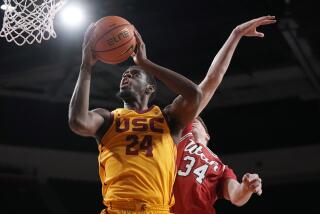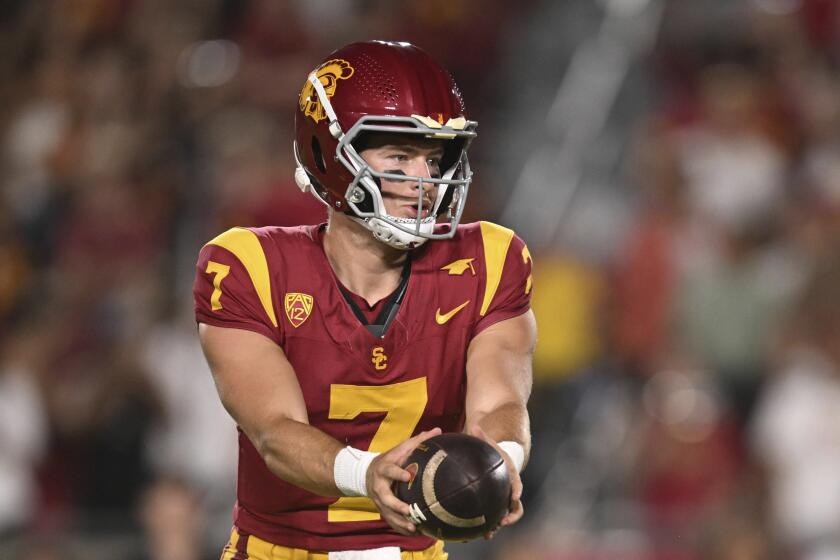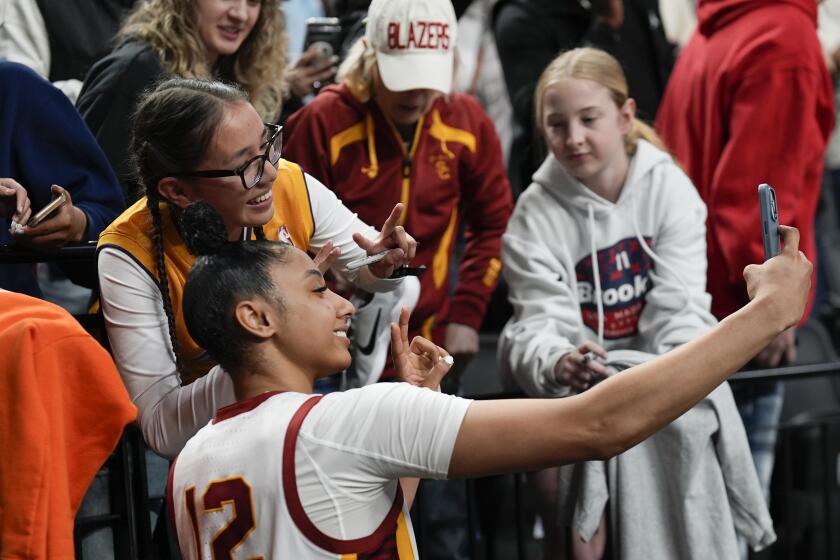Before Stanford, USC finds explanations for its run-defense failure. And, it hopes, some fixes too.

Cameron Smith found himself in the unusual position of evaluating USC’s game film in real time last Saturday. Serving a half-game suspension for a targeting penalty during the second half of the Trojans’ Rose Bowl victory last January, the linebacker watched Western Michigan have its way with USC’s run defense on a television in the locker room.
He dissected the first half as it happened.
“I got a perfect view,” he said.
What he watched he had never seen before. There was confusion, disorganization. Outside linebacker Porter Gustin’s back was turned to the line of scrimmage on a number of plays as he waved and tried to communicate defensive calls. Safety Chris Hawkins ventured down closer to the line of scrimmage to do the same.
Nor did Smith recognize what he saw in Western Michigan’s offense. The Broncos, he said, were running formations that USC hadn’t planned for.
USC players and coaches have pieced together a few hypotheses for why the Trojans front seven — expected to be a fearsome, imposing pillar of the team — was humbled against Western Michigan, which ran for 263 yards. How accurately USC has diagnosed its problems and how quickly it addresses them will help determine a crucial game Saturday against Stanford, a notoriously physical running team.
The first explanation is simple: Western Michigan was just plain good on the ground.
“They’re no joke,” Gustin said.
The second explanation also portends well. The Trojans rely heavily on Smith’s experience to align their defense. USC struggled most acutely in the first half without him.
But one concern lingers. USC’s defensive players say they weren’t completely manhandled, just out of place. They hadn’t planned for many of the sets Western Michigan ran. In other words, they had months to get prepared, and they weren’t.
Smith’s absence compounded the alignment issues. And the performance highlighted how crucial he has become to the entire defense. Western Michigan’s yards per attempt dipped by 1.5 yards from the first half to the second, a 25% decline.
Smith is responsible for communicating play calls, diagnosing offenses and calling out the strong side. Sometimes he’s given two defenses and must pick the right one based on the offense’s formation.
“So it’s like being a quarterback,” coach Clay Helton said. “It’s like having to call the audible.”
Without Smith, Gustin said, the whole defense was thrown off.
“We’re just all comfortable as one unit,” Gustin said. “We’ve been with him, he’s been with us, for a long time now.”
Smith’s replacement, Jordan Iosefa, played well, Hawkins and Smith said. But he lacked experience. He relied on help to make the right calls and adjustments. Hawkins had to act like his editor, revising as necessary.
“When Cam’s in there, I don’t have to do that,” Hawkins said. “I know he knows exactly what he’s doing.”
Still, USC should be able to function without Smith. But the turnover of almost the entire offensive staff at Western Michigan left USC with a problem. USC didn’t know what offense it would see.
The Trojans made some predictions. They didn’t expect to see much “12” personnel: one running back and two tight ends. They predicted wrong.
“They threw something that we’ve never seen before,” Smith said. “They went a lot of 12 personnel and we weren’t expecting that at all. So we didn’t practice it at all.”
Helton said that defensive coordinator Clancy Pendergast did have a package for “12” personnel, and USC did practice sparingly for it,.
“Wish it would’ve been more,” he said.
Gustin called defending the Broncos “kind of a guessing game.”
But it’s also true that Western Michigan used other, more typical formations for most of the game. And it still ran the ball effectively.
The Trojans should benefit from familiarity with Stanford. They know what the Cardinal wants to do: use big bodies to create space for their running backs. They pound the ball on the ground.
Stanford also runs enough two tight-end packages that USC can remain in its base defense, with three linemen. USC used a nickel defense heavily against Western Michigan, with only two linemen.
But Stanford also changes formations often. Helton said that Stanford used six different personnel groups in its first 10 plays during its opener. Stanford coach David Shaw, Helton said, has “always done a good job of keeping you off base.”
That type of coaching gave USC fits against Western Michigan. Come Saturday, Hawkins pledged, “We’ll be ready for it.”
Quick hit
Helton said injured right tackle Chuma Edoga “turned a corner, and I expect him to play.”
Follow Zach Helfand on Twitter @zhelfand
More to Read
Go beyond the scoreboard
Get the latest on L.A.'s teams in the daily Sports Report newsletter.
You may occasionally receive promotional content from the Los Angeles Times.







